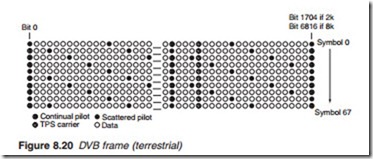Terrestrial channel encoder
Figure 8.19 shows the main elements of a DTTV transmission system. The 188-byte multiplexed MPEG-2 transport stream is first randomised and then processed through the inner coder, interleaver and outer coder and punctured in the same way as for a satellite system. However, DTTV broadcasting requires further error protection, provided by the inner inter- leaver, before the packets can be framed, modulated and transmitted via UHF aerial. The inner interleaver is a frequency interleaver which carries out bit interleaving as well as symbol interleaving; here ‘symbol’ refers to the bits being transmitted by one OFDM carrier during one OFDM sym- bol period. The error-protected packet must now be framed before the modulating stage.
A DVB-T frame consist of data from 68 consecutive OFDM symbols together with reference pilots and transmission parameter signalling (TPS) information scattered among the data (Figure 8.20). Four OFDM frames constitute one super-frame, and one super-frame will always carry an integer number of MPEG-2 packets. There are two types of pilots: contin- ual pilots and scattered pilots. Continual pilots are spread at random over each OFDM symbol. They are used to modulate the same carriers on all OFDM symbols. Scattered pilots are spread evenly in time and frequency across the OFDM symbol. The continual pilots are used for synchronisa- tion and phase error estimation whereas the scattered pilots allow the receiver to take account of echoes and other impairments when estimating the channel characteristics. Channel parameters such as the mode (2K or
8K), guard interval length, modulation type and code rate have to be included within the transmitted bitstream. For this reason, a TPS channel is added to the OFDM signal. The TPS information, 68 bits in length, is car- ried by specified carriers spread over the entire OFDM frame. One carrier in each symbol is allocated to carry one bit of TPS using simple BPSK.
The OFDM modulation is implemented using an inverse fast Fourier transform (FFT) where the OFDM carriers (1705 or 6817) are modulated by each frame. The modulation of the carriers may be BPSK (used for TPS channel), 16-QAM or 64-QAM as determined by the service provider. The guard interval is added next, followed by a digital-to-analogue converter to prepare the signal for the RF interface.
